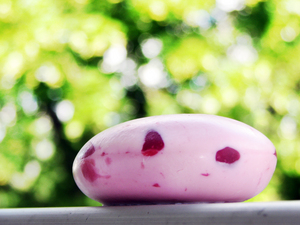Many people make their own soap for a variety of different reasons. Some enjoy soap making as a hobby and give the soaps as gifts, while others make there own soap for personal use. Once you have learned the basics behind soap making, you will probably make soap for both gifts and personal use. Making your own soap is simple to do and many also find it to be fun.
What is Soap?
When you read the ingredients on a soap label that you have purchased, you would definitely get the impression that a lot goes in to making a bar of soap. That simply isn’t true. All that is required to make a bar of soap are two things, a fat and lye. Of course, the more you ad to your soap the more luxurious your soap will be, but again the basic bar is just fat and lye.
Ingredients
If you have never made your own soap before, the best soap making method for you would be the melt and pour method. It requires no handling of the dangerous chemical lye, as the actual soap compound is already made. Although this may not seem as crafty or fun, it is really the best way to get started. To use the melt and pour method, you will need to purchase an uncolored, unscented soap base. There are many places you can purchase a soap base from, craft stores usually sell soap bases and the Internet is another great resource for purchasing soap bases as well. You will also need a fragrance for your soap, essential oils are usually best. Additionally, you may want food coloring to color your soap and make it a bit more fancy looking.
That Smells Nice
Essential oils are an important part of your soap, the fragrance of the soap not only personalizes your soap, but additionally they can provide some health benefits. Although there are many essential oils that you can use for making your soap, there are a few that are recommended. Tea Tree oil is my personal favorite. Tea Tree oil has a multitude of benefits, it is a natural antiseptic, antibiotic, fungicide and it can help with a variety of skin conditions including acne. Tea Tree oil also has a fresh, clean smell that isn’t really gender specific so it will work well for your entire family. Patchouli is another essential oil that works well in soap making. Patchouli does have a musky smell, so it is sometimes best to mix it with other essential oils. Patchouli is known for treating skin conditions such as acne, eczema and some belive it helps the appearance of aging skin. Grapefruit essential oil works well as an aromatic type soap. The smell of grapefruit essential oil is said to relive stress, anxiety and depression. Again, these are just some of the many essential oils you can use for making your own soap.
Putting it all Together
Once you have selected your ingredients and you are ready to make your soap, you will need a few things from your kitchen. You will need a microwave safe bowl, mixing spoons, measuring spoons and something to put your soap in so that it molds into the desired shape. First, you will measure out the amount of soap base needed for your formula. There are many formulas available online, but we will use a basic one for reference. You will use one block or bar of your soap base to start. Melt the soap base either in the microwave or in a double boiler. Make sure that you melt the soap slowly to avoid burning it. Once the soap base is melted add about 1/2 an ounce of your chosen essential oil and a minimal amount of desired coloring. Your soap is now ready to be poured into the molds for setting. Some people like to add some extra ingredients before they pour their soap in to the molds. Some of the things people add are, a tablespoon of honey, a tablespoon of oatmeal, a teaspoon of beeswax or a tablespoon of shea butter. Of course as with the essential oils there are many things people add to their soap for a multitude of reasons. Try and keep it basic at first by only adding fragrance and maybe one other extra ingredient. Your soap should harden or reform after several hours. Once your soap is hardened you can wrap it up in either plastic wrap, wax paper or another non-stick material.
